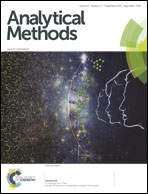Salting-out induced liquid–liquid microextraction based on the system of acetonitrile/magnesium sulfate for trace-level quantitative analysis of fluoroquinolones in water, food and biological matrices by high-performance liquid chromatography with a fluorescence detector
Abstract
A convenient, robust and economical salting-out induced liquid–liquid microextraction (SILLME) method coupled with high-performance liquid chromatography/fluorescence detector (HPLC/FLD) for sample preparation, extraction and trace-level quantitative determination of six fluoroquinolones (FQs) in different samples was developed. The critical factors that influence the extraction efficiencies of the target analytes, such as the type of extraction solvent and salting-out reagent, the ratio of extraction solvent to salt, pH value and extraction time, were investigated. The system of acetonitrile/magnesium sulfate showed good extraction efficiencies for the target analytes. Under optimum conditions, the correlation coefficient (r2) was obtained within a range of 0.9990–0.9998 by spiking ultrapure water over a range of 0.002–0.100 μg mL−1. Excellent sensitivity was attained with limits of detection (LODs, S/N = 3) ranging from 0.07–0.41 ng mL−1, 0.09–0.62 ng mL−1, 0.48–2.49 μg kg−1, 0.80–5.00 ng mL−1, 0.78–5.58 ng mL−1 and 0.40–5.30 μg kg−1 for ultrapure water, field water, honey, milk, swine plasma and muscle, respectively. While precision with inter- and intra-day relative standard deviations (RSDs, n = 5) for ultrapure water were observed in the range of 0.4–4.0% and 1.3–6.8%, respectively. Finally, the developed method was successfully applied to all of the abovementioned matrices as a promising method for the analysis of FQs.


 Please wait while we load your content...
Please wait while we load your content...